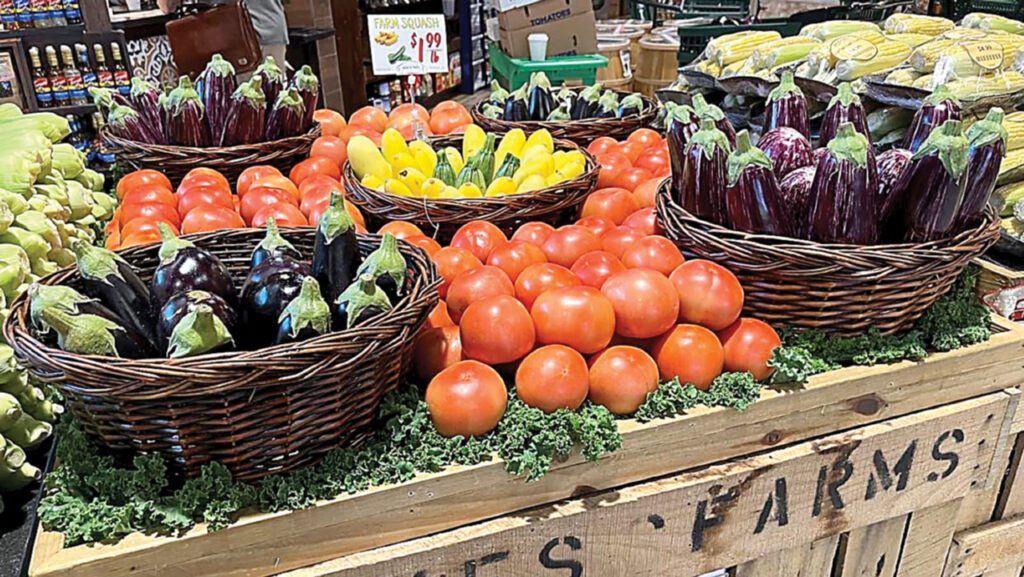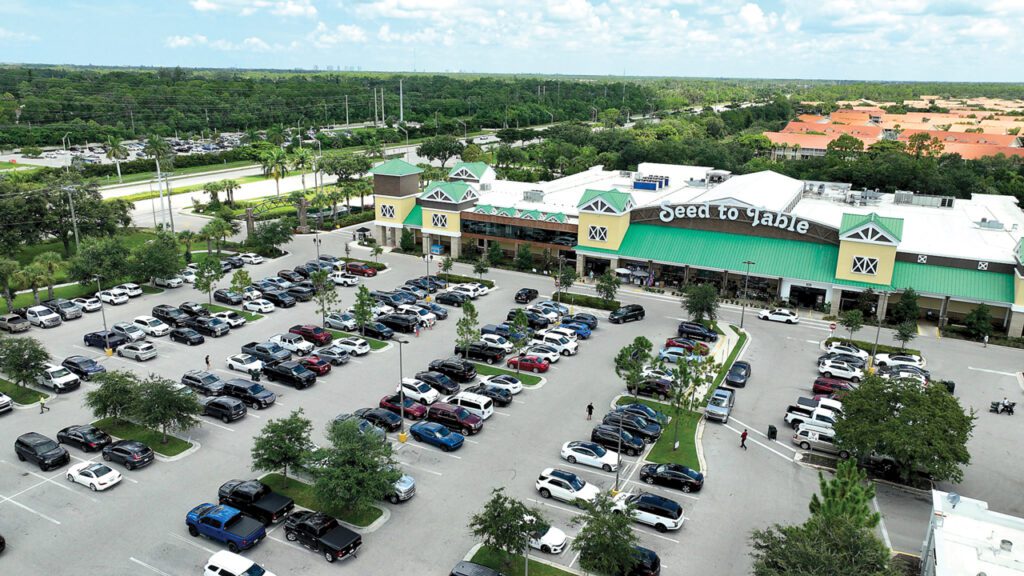Walk into the Seed to Table grocery store in Naples, FL, and the first products you see are fresh fruits and vegetables. In the late winter and early spring season, there might be bin-sized displays of whole watermelon, tri-color presentations of green, red and yellow bell peppers, and baskets of eggplant, green and yellow summer squash, and vine-ripe tomatoes set atop a free-standing crate-style display with a farmers market vibe.
Sure, produce is the first department in many independent and chain supermarkets. What sets Seed to Table apart is that its just-picked produce offerings, from founder Francis Alfred “Alfie” Oakes’ Oakes Farms and further afield, aren’t found only in one section of the store. Instead, shoppers will find fresh produce in made-from-scratch offerings in nearly every store department.
It’s the soup-to-nuts ways to buy and eat fresh produce that is a big part of why Seed to Table earned the Produce Business Most Innovative Independent Retailer Award for 2025. This industry-nominated recognition is part of a special award series to honor innovative companies and individuals who masterfully buy and sell fresh fruits and vegetables to drive overall consumption.
For instance, there are ready-to-grill beef and chicken kabobs threaded with a stoplight pattern of bell pepper chunks in the meat department; lobster, calamari, and seaweed salads in seafood; real onions in the bakery’s onion loaf, blueberries in the pie, and bananas in the banana walnut bread; 100% fresh squeezed orange juice in dairy; and eggplant Parmesan and grab-and-go veggie wraps in the prepared foods deli — to name a few.
That’s not all. There are six culinary outlets and four bars seating up to 530 patrons in the 80,000-square-foot store. Fresh produce is abundant in everything from veggies as a side for weekend prime rib dinners in the main dining area to the Oakes Farms’ mixed greens salad in the Food & Thought Organic Café, asparagus in the Florida rolls at the Sushi/Asian concept, lettuces and more in the cobb, Caesar and garden salads at the Salad Bar, and fruit smoothies, veggie shots and elevated juices on the Bar Menu.
“Seed to Table is my version of farm to table,” says Oakes, who serves as the chief executive. “It’s all about having food that either we grew, or we know how it’s grown, or know where it’s grown. It’s an integrity that I felt was being lost.
“Plus, everything is made from scratch every day, from our in-house made salsa and guacamole sold in an 8-foot set in the produce department to all our prepared foods. Seed to Table represents what this concept is all about.”
NEARLY A CENTURY IN THE MAKING
Fresh fruits and vegetables became a wage-earning trade for the Oakes in the 1930s when an 11-year-old Banny Oakes began selling produce in front of the family’s house at the foot of Delaware’s St. Georges Bridge to help make ends meet.
The stand stood for several decades until Grandpa Banny’s son, Frank, relocated the business to southwest Florida in 1976. By the 1980s, Frank had opened open-air fruit and vegetable markets in Collier County and a small retail store. Frank’s son Alfie displayed his passion for produce by building the store’s produce sets as a pre-teen.
Frank thought his son would eventually run the family business. Instead, the junior Oakes launched his own business, which soon became businesses — a retail store by age 18, a farm at 19, and a wholesale business at 21.
“I was blessed to start early and had this huge motivation,” Oakes says. “My father was hugely unsuccessful in creating a store that could make money, but he was super successful in attracting customers. People loved him. I’d watch the farmers come in, and it seemed like they were doing well. They made money. The wholesalers came in with their new semis. They were doing well, too. It seemed like everyone was doing well except my dad.
“I started developing the idea of doing it all — the farming, the wholesaling, and the retailing — in those early years. I was thinking of it in a much smaller way than what Seed to Table has become. But my thought was if we could have our hands in every part of the supply chain, then there’s money to make because everyone was making money. That’s the course I started building toward.”
Today’s grand scale of Seed to Table took shape in Oakes’ mind about 20 years ago. He communicated his concept at a Share Group conference of grocery CEOs. It was a time when industry forecasters predicted a shrinking of the center of the store in favor of perimeters blossoming with perishable departments.
“I told them I wanted to create a store that was all perimeter. They asked how many people it would take, because labor was becoming a bigger issue. I hadn’t put pen to paper to that at the time, but we ended up needing 800 people to get the store opened on Dec. 17, 2019. If it hadn’t taken off in the first month or so, that would have been it. But I wouldn’t compromise on my vision of fresh, healthy food made from scratch,” he says.
IT STARTS WITH THE SEED
Oakes’ gold quality standard for fresh produce is flavor versus fruit and vegetable varieties bred to ship like hardware and taste like the box in which they are packed. He feels that the industry has been headed back in the right direction over the last five to 10 years, with growers’ greater focus on flavor-based breeding programs.

Flavor is his mantra at Oakes Farms, which encompasses 3,500 acres of farmland in Immokalee, FL, and grows over 70 types of fruits and vegetables, including peppers, eggplant, squash, cucumbers, beans, corn, lettuces, herbs, and, more recently, potted flowers and plants as well. More unique products are grown here, too, like patty pan squash, Dominican eggplant, and fresh pickling cucumbers.
Vertical integration means a dedicated harvest crew goes to each farm daily to pick exclusively for Seed to Table. In the peak Florida season, there might be 75 to 100 different items that come field to store on a given day.
The farm also ships its produce to other independent retailers throughout the East Coast, using Oakes’ wholesale distribution company, South Florida Produce, also in Immokalee, to sell the product.
Oakes will have his 120-acre grove of variety citrus ready for production in the next two years, and Oakes Farms also has 170 Jersey cows that supply Seed to Table with raw milk.
“There are not many places, unless you go to a u-pick operation, where harvest starts first thing in the morning and it’s delivered to the store by noon,” says Oakes. “Our Florida produce is so fresh that when shoppers buy it, it was still growing in the field when they woke up that morning.”
“Our Florida produce is so fresh that when shoppers buy it, it was still growing in the field when they woke up that morning.” — Alfie Oakes, founder, Seed to Table
Apples, bananas, kiwi fruit, and an A to Z of everything else that doesn’t grow on the farm or isn’t available seasonally are for sale in Seed to Table’s produce department. Strategic sourcing comes from Oakes’ huge advantage of owning a wholesale produce business since his early 20s.
For example, he gets sweet potatoes for Seed to Table from Garber Farms in Louisiana. Oakes has relationships with melon farmers in Delaware, and he buys all his mixed veg during the summer from D’Ottavio Produce, in southern New Jersey. Several California growers are longtime fruit providers of apples, cherries, and grapes for Seed to Table.
“We try to have a diversity of products,” he says. “Obviously, there are big displays with all the main familiar fruit and veg items. There are also whole sets of tropicals. Starfruit is easy for us to grow. There’s also cherimoya, passion fruit, persimmons, and many different tropicals you don’t see in other stores.”
The produce department is 6,000 to 7,000 feet in size, or less than 9% of Seed to Table’s square footage. However, this space punches well above its weight, generating 15% to 18% of the store’s total sales. There are no aisles here, but a planogram that encourages shoppers to wander throughout the entire department and warm, wood-paneled store.
TURNING SHRINK INTO PROFIT
Oakes says merchandising in the produce department starts with bringing in the best and freshest product. “I learned early on that you can’t leave mediocre stuff on the shelf. Everybody will have it, so it’s all about finding a place for it and utilizing it.”
All the racks are pulled down every morning, he adds. “All the soft tomatoes, and sometimes the No. 2 misshapen tomatoes from the farm, go into our fresh in-store salsa. We go through 30 to 40 cases of ingredients each day. Our employees make salsa and guacamole fresh every day and all day in big batches in 20-gallon pans right in front of customers. Last year, we sold $2.4 million in salsa and guacamole from an 8-foot set.”
Produce staff are available to cut fresh fruits and vegetables to make meal prep easier or make healthy snacks readily available. There’s also an in-store pineapple corer. Oakes’ philosophy is that if something can be done in-house, it is.

The sheer volume of Seed to Table’s foodservice operations, valued at $100,000 in prepared food sales on a typical day and up to $400,000 on holidays, enables the retailer to use much of what other grocer’s produce departments would count as shrink.
For instance, limes culled from the rack get cut up for tacos. Baking potatoes get pulled as sides for prime rib steaks. If corn is harvesting heavy, it gets put on the menu as a side to entrees. Soft strawberries get made into Alfie’s Strawberry Jam in big copper pots.
“As long as you’re paying attention and have a lot of people that care and are diligent, finding a place for everything works,” says Oakes. “At the end of the day, our net margins at this store blow any grocery store in the country away, and having a good bit of prepared food is a big reason.
“I was a little nervous when I opened that maybe people wouldn’t appreciate all that went into doing everything from scratch. But the reality is that people do know the difference. They can feel it, taste it, and even enjoy the way they feel after they’ve eaten it.”
HAPPIEST PLACE IN THE UNIVERSE
Oakes says some shoppers have called Seed to Table the Disney World of grocery stores. It’s the experience that draws customers in and keeps them there.
“My grandmother would take me to the farmers market in Delaware when I was a kid. It was crazy busy with all kinds of stuff going on. I loved going there. It’s a memory embedded in my mind that I wanted to re-create in the store,” says Oakes.
The store opens at 7 a.m. daily. There’s a children’s area called the Little Farm, where parents can sign their children in for up to 90 minutes of secure, supervised play time while the adults shop and eat. At night, Seed to Table becomes a dining, music and live entertainment venue offering a mix of fast and slow-paced energies. Hops & Vines, the retailers’ second-floor liquor bar and dining area, is open until 2 a.m. on Friday and Saturday. Thus, Seed to Table generates traffic for up to 19 hours a day.
“People will come in to shop in the morning and end up spending the day. I don’t think that happens at any other grocery store,” Oakes says.
LOOKING AHEAD
Oakes also owns and operates two Food and Thought stores in Naples, FL. At 22,000 to 27,000 square feet in size, they aren’t as big as Seed to Table. However, the focus — true to the passion of Oakes’ late father Frank — is militant organic, i.e., everything inside is 100% organic. This includes produce from Oakes Farm, raw milk from his cows, heirloom wheat breads, and fresh-squeezed orange juice.

He balances the low margin of organic produce with the higher margins of a restaurant and juice bar as part of the concept. In the future, Oakes’ vision is to sprinkle his Food and Thought stores throughout the U.S.
Will there be a second Seed to Table?
“I never say never,” Oakes says. “But I plan to open my original retail store, Oakes Farms, which went underwater with Hurricane Ian a few years ago. It won’t be called Seed to Table and will be a different version than before, but I can tell you it will sell our farm fresh produce and be a destination spot


